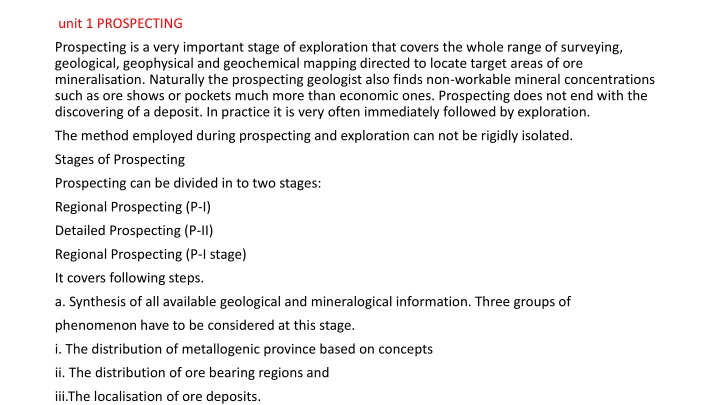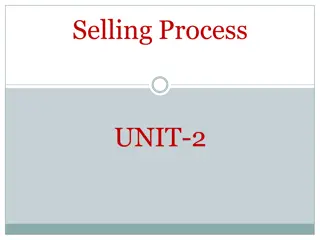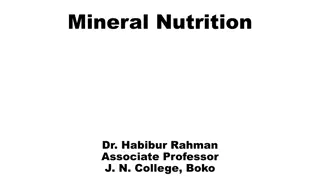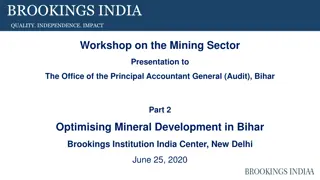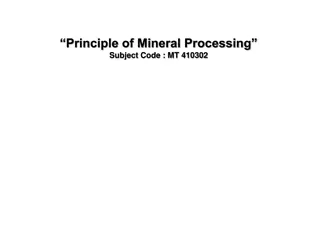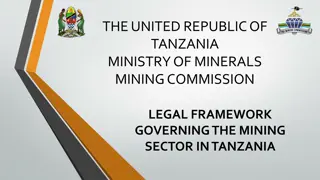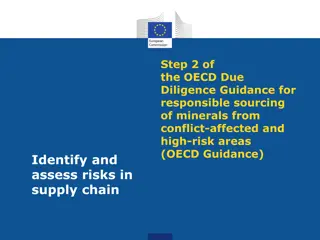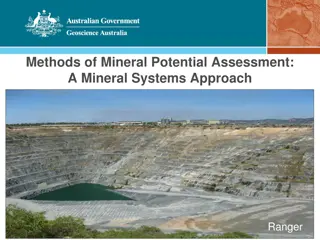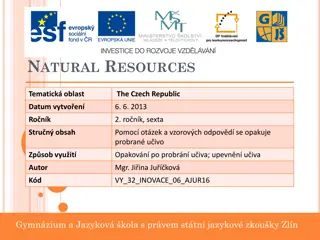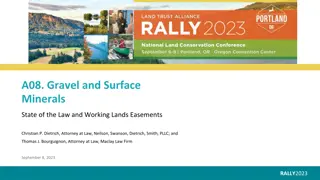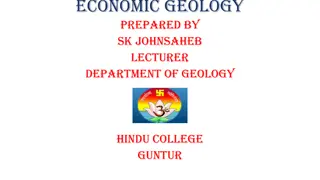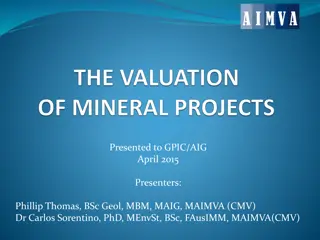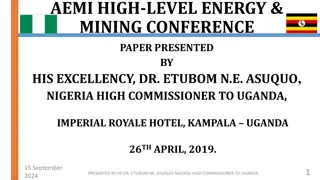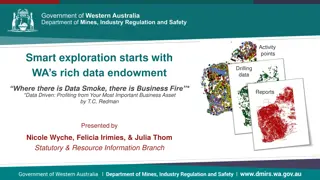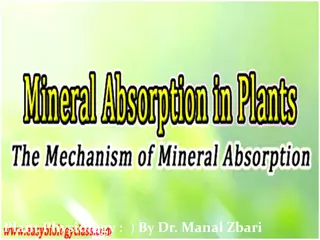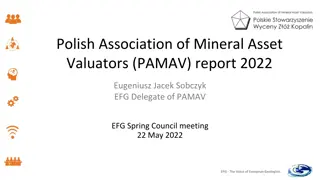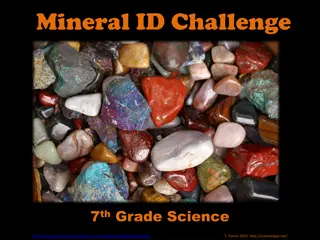Importance of Mineral Prospecting and Exploration
Prospecting and exploration are crucial stages in the search for mineral deposits, involving a range of geological, geophysical, and geochemical mapping techniques to identify potential ore mineralization areas. These stages include regional and detailed prospecting, aiming to determine quantity, quality, and economic viability of mineral deposits through various investigations.
Download Presentation

Please find below an Image/Link to download the presentation.
The content on the website is provided AS IS for your information and personal use only. It may not be sold, licensed, or shared on other websites without obtaining consent from the author.If you encounter any issues during the download, it is possible that the publisher has removed the file from their server.
You are allowed to download the files provided on this website for personal or commercial use, subject to the condition that they are used lawfully. All files are the property of their respective owners.
The content on the website is provided AS IS for your information and personal use only. It may not be sold, licensed, or shared on other websites without obtaining consent from the author.
E N D
Presentation Transcript
unit 1 PROSPECTING Prospecting is a very important stage of exploration that covers the whole range of surveying, geological, geophysical and geochemical mapping directed to locate target areas of ore mineralisation. Naturally the prospecting geologist also finds non-workable mineral concentrations such as ore shows or pockets much more than economic ones. Prospecting does not end with the discovering of a deposit. In practice it is very often immediately followed by exploration. The method employed during prospecting and exploration can not be rigidly isolated. Stages of Prospecting Prospecting can be divided in to two stages: Regional Prospecting (P-I) Detailed Prospecting (P-II) Regional Prospecting (P-I stage) It covers following steps. a. Synthesis of all available geological and mineralogical information. Three groups of phenomenon have to be considered at this stage. i. The distribution of metallogenic province based on concepts ii. The distribution of ore bearing regions and iii.The localisation of ore deposits.
b. Reconnaissance mapping on 1:100,000 or 1:250,000 scale. c. Systematic geological mapping on 1:50,000 scale (GM). d. Large scale geological mapping on 1:25,000 scale to 1:10,000 scale (LSM) or specialized thematic mapping. (STM) of potential litho-packs and favorable structural/domains. e.Electro-magnetic Airborne Geophysical Surveys (Magnetic & Radiometric). f. Regional geochemical sampling (wide spaced) GCS. g. Regional geophysical survey (wide spaced) GP. h. Photo geological and remote sensing studies PGRS.
unit 1 MINERAL EXPLORATION Exploration embraces a whole complex of investigations essential for determining the industrial importance or economic viability of a mineral deposit, hence covered with answering the complex range of geological, mining and economic problems. OBJECTIVES 1.Determination of the quantity and quality of the mineral and to ascertain the natural and economic conditions of occurrence. 2.Quantity is determined by volume so consequently the aim is to ascertain the shape and size of the deposit (geometerisation). 3.Quality: It comprises chemical composition of ore body, mineralogical composition, technological properties (interlocking of grains, grain size etc.) and grade of metal, deleterious constituents and by products. 4.Quantity and quality are dependant as the shape of the ore body is determined on the basis of the accepted cut off grade (which can be mined economically). 5.Besides geological data, geotechnical information about strata condition, hydrogeological information, high grade power line, approach and transport facilities, reserved forest areas, environmental aspects, local building material, economy of the local population, economic pattern of the area has to be studied.
iv. Time factor is most important for the national economy. The principle of least outlay, seem to suggest reducing the volume of exploratory work to a minimum. However, optimum densities for exploration grids and optimum spacing of sampling points should be required as far as practical. STAGES OF EXPLORATION The whole exploration programme is divided into two stage i. Regional Exploration or Preliminary Exploration (EI) a. To make a regional assessment of mineral potentiality and to select prospects which have reasonable possibility of economic exploitation. b. To establish the controlling parameters of ore localisation. c. To make broad estimates in respect of length, width, grade depth extension and reserve and grade of the ore bodies. d. To examine the amenability of the ore to beneficiation on laboratory scale.
Exploratory mining is also carried out in this stage (1) to test the physical continuity of the ore zone/lode from drill hole to drill hole along strike and depth, (2) to correlate the lodes and study the behavior and nature of barren partings, (3) to study the condition of host and wall rocks (4) to obtain large bulk samples for beneficiation studies, (5) to ascertain the ground water conditions in the mine, and (6) to evaluate the general method and economics of mining.
Lithological and Facies criteria : Different rock formations are characterized by deposits of a definite lithological composition. Lithological criteria are a powerful tool in the search for mineral deposit. Iron ore - Lacustrine and bog facies. Manganese - Oolitic manganese ore facies. Phosphorite - Platformal and geosynclinal facies. Bauxite - Associated with lateritic conditions. Coal - Terrigenous, Platformal and geosynclinal. Muscovite, Phlogopite and graphite - Ancient metamorphic schists. Nickel (Silicate) - Develop as blankets in the mantle of waste of ultrabasic rocks and in the zones of contact of these with limestone. Tungsten, Tin and Molybdenum - Skarn rocks. Pb, Zn, Cu, Ag - Carbonates.
Norite : Ni, Cu. Diabase : Ag, Co, Ni. Diorite-Monzonite : Cu Granodiorite : Porphyry copper Quartz Monzonite : Mo Granitoids : Au, Cu, Sn, W, Li, Nu, Ba, Su, Bi, Mo Basic volcanics : Massive sulphides Cu-Zn- Pb
TECHNIQUES OF EXPLORATION It involves the following features: i. Large scale mapping on 1:1000 or 1:2000 scale (Detailed Mapping). ii. Exploration is done by opening of pits, trenches and by drilling. ii Interpretation of the collected data, preparation of sections and plans. iv. Quantity and quality determination of ore. v. Ore body modeling. vi. Reserve calculation.
METHODS OF PROSPECTING AND EXPLORATION A variety of methods are available for exploration. Each has specific use, value and somezzinherent limitations. Choosing the techniques for specific field conditions calls for a broad knowledge of the methods and their limitations. These methods can be broadly divided into : (i) airborne exploration methods and (ii) ground exploration methods. The airborne exploration methods are listed below: Airborne Exploration Methods Remote sensing Photo geological study Colour ,Black and white ,Multispectral Aerial examination Airborne geophysical exploration Aeromagnetic surveys Electromagnetic surveys Spectrometric surveys
Ground exploration methods are the most important in delineating the physical boundaries and chemical nature of the individual deposits and consist of two operations, viz. Detailed ground definition of targets and three dimensional sampling. Ground exploration methods are listed below: Ground Exploration Methods Detailed ground definition of targets Regional Geological mapping Geochemical sampling and mapping: Rock sampling ,Soil sampling, Stream sediment sampling ,Water sampling. Geobotanical sampling and mapping Grid sampling of plant species. Ground Geophysical methods :Gravity method,Magnetic method ,Seismic method, Electrical method ..Resistivity ,Self-potential ,Induced polarisation
Unit 1 DIRECT FIELD EVIDENCE (GUIDES) The following features need to be examined in detail to locate mineral deposits: 1. Float ore 2. Topography 3. Stratigraphy 4. Lithology 5. Contact surfaces 6. Structure 7. Alteration haloes and 8. Old workings, tailing dumps and evidence of smelting activity of metallic ores, etc.
Float ore In practically every case of exposed deposits, float ores will be present. Float ores may be close to the outcrop or they may be at considerable distances. Therefore, the first thing that a prospecting geologist should look for is the presence of float ore. Topography All rocks, minerals and mineral deposits are consistently under attack by natural weatherin agents. It is to be expected that the more resistant formations would give rise to a prominent land form. This phenomenon has presented us with two practical field guides which are in topographically prominent features and topographically subdued features. The topographically prominent features are generally associated with hard resistant ore deposits. A typical example of this guide is the case of the iron ore deposits of India. Almost all the iron ore deposits occur on top of prominent ridges and other topographical land marks. Thus, in a geologically favourable terrain, iron ores will generally be confined to hill/ridge/plateau tops and this forms an important field guide for locating them. Iron rich gossans and cappings form prominent land marks in the Khetri copper belt in India. The old workings seem to have acted as a better guide in this case. Subdued topography generally indicates less resistant rocks. Thus, an easily weathered rock like limestone or dolomite generally gives rise to a flat topography. This phenomenon is typically demonstrated by the limestone of Kaladgi Basin, Vindhyan and Cuddapah rocks which are structurally less disturbed. In all these cases, limestones occur interbedded with sandstones and quartzites, the former giving rise to a flat topography and the latter standing out prominently as ridges.
Structure Structural features like folds, faults, shear zones, fracture zones, etc. may act as the prime location of mineralisation. In such cases, the search for deposits should be concentrated around favourable structures. Alteration haloes Mineralisation associated with igneous and metamorphic processes usually leaves an alteration halo around the orebody which is a direct evidence of mineralisation. This halo may be defined by the occurrence of one or more minerals or by the intensity of fracturing or by metal ratios. Naturally, the recognition of such evidence calls for careful search, geological mapping, collection of chip samples for chemical analysis, etc. Such haloes are in the asbestos deposits of Cuddapah where asbestos veins are surrounded by a halo of serpentinisation.
Geophysical Method Geophysical and geochemical techniques typically measure objective characteristics that are possessed by all rocks to some degree and result in the collection of large amounts of geographically referenced digital data. The first type of survey is a mapping of the areal distribution of a particular rock or soil characteristic it could be, for example, patterns of electromagnetic reflectance, magnetic susceptibility, rock conductivity or element concentrations/ ratios in rocks soils or drainage sediments. Magnetic Surveys The instrument used for magnetic surveys is called a magnetometer. Magnetometers record disturbances in the earth s magnetic field caused by magnetically susceptible rocks. Since all rocks are magnetically susceptible to some degree, a map of magnetic variation at surface (called a Total Magnetic Intensity or TMI map) can provide an image of lithology distribution an image that to some extent reflects the three-dimensional distribution of rocks and is not affected by thin superficial cover. Magnetic maps are so generally useful to the explorationist that they are easily the most widely used geophysical technique, both as an invaluable aid in regional mapping and for the direct location of those ore bodies that have a distinct magnetic signature.
Pyrrhotite can be an important magnetic source in some units such as black (carbonaceous) slates and higher grade metamorphic rocks. Serpentinized ultramafic rocks are strongly magnetic due to the presence of fine magnetite, but metamorphosed ultramafic may have only a low magnetic susceptibility. Oxidized granites have strong magnetic intensity, whereas more reduced variants are magnetically quiet. Units of intermediate calc alkaline volcanic origin can be markedly magnetic, and similarly sediments derived from them. Contact intrusive aureoles may be magnetic, particularly around oxidized granites. Regolith units with concentrations of maghemite,2 particularly channels with pisolitic maghemite gravels, may show a distinctive magnetic response. Alteration associated with hydrothermal fluids provides an enhanced magnetic response in some cases, and reduces it in others.
Gravity Surveys Gravity surveys measure lateral changes in the density of subsurface rocks. The instrument used, called a gravimeter, is in effect an extremely sensitive weighing machine. By weighing a standard mass at a series of surface stations, the gravimeter minute changes in gravity caused by crustal density differences. A good example of the successful use of a gravity survey as an aid in ore discovery is the location of the high-grade Hishikari epithermal gold deposit of Japan (Izawa et al., 1990). Here, a detailed gravity survey was used to define a buried mineralized structure in an area of known mineralization. The key to the successful use of the technique in this case was the high degree of understanding of the local geology and mineralization, which was used in the design and interpretation of the survey. Modelling of the gravity response for the likely range of size, depth, and SG of targets is an important reality check before the technique is used for direct exploration. The gravity field at the surface of the Earth is influenced, to a very minor extent, by density variations in the underlying rocks. Rock densities range from less than 2.0 Mg m 3 for soft sediments and coals to more than 3.0 Mg m 3 for mafic and ultramafic rocks. Many ore minerals, particularly metal sulfides and oxides, are very much denser than the minerals that make up the bulk of most rocks, and orebodies are thus often denser than their surroundings.
Radiometric Surveys These surveys measure the natural radiation emitted by rocks at surface. The data are collected and presented in a similar way to magnetic data. Radiometric measurements are often carried out from a low-flying aircraft at the same time as air magnetic surveys. Radiometric measurements can also be taken with land-based instruments that can be used at ground stations or lowered down drill holes. The instrument used is called a spectrometer.
The most abundant naturally occurring radioactive element in the crust is the potassium isotope 40K, largely incorporated into the crystal structure of the rockforming mineral orthoclase. Of lesser importance as a source of radiation is thorium (found in monazite, an accessory mineral of some granite and pegmatite bodies). The radioactive mineral normally sought by explorers uranium is seldom abundant, but at low concentrations can characterize particular rocks such as highly fractionated granites or some black shale sequences. Electromagnetic (EM) Surveys Electromagnetic surveys aim to measure the conductivity of rocks,
Electrical Surveys conductive rocks below. Passing an alternating current through a wire or coil, which is either laid out along the ground or mounted in an aircraft flying overhead, provides the primary field. The curren induced in conductive rocks produces a secondary field. Interference effects between the primary and secondary fields provide a means of locating the conductive rock body. Since many massive metal sulphide ore bodies are significantly conductive, EM techniques are mostly used as direct ore-targeting tools in the search for this type of deposit. EM systems work best for ore bodies within 0 200 m of the surface. Although, theoretically, larger primary fields and more widely spaced electrodes can give much deeper penetration, the problems of interpreting the results of EM surveys go up exponentially with increasing depth of penetration. Ground based EM techniques are relatively expensive procedures that are applicable to defining drill targets for specific mineralization styles within established prospects or highly prospective belts. EM systems are available which can be used down drill holes to measure the effects of currents flowing between the hole and the round surface or between adjacent holes.
airborne EM techniques have played a major role in discovery include the massive sulphide deposits. Electrical Surveys Electrical surveys are all ground based. In their simplest form, they put an electric current directly into the ground and measure, by means of arrays of receivers, the resistance of the rocks through which the current passes. Such surveys are therefore often called resistivity surveys. Current is normally conducted through the ground by the movement of charged ions in pore fluids. Metallic sulphides, which can conduct electric current electronically, can often be detected as zones of anomalously low resistance. SPONTANEOUS POLARIZATION (SP) Natural currents and natural potentials exist and have exploration significance.
Induced polarization is virtually the only geophysical method that is capable of directly detecting concealed, disseminated sulphides in the ground. After magnetic surveys, the induced polarization (IP) technique is one of the oldest geophysical methods to be used in mineral exploration. IP is a special type of electrical survey that utilizes the electrochemical (galvanic) effects caused by a current passing through disseminated metal sulphides. Problems in using electrical surveys can be caused by the short-circuiting effects on the input current that can be caused by salty near-surface groundwater in deeply weathered terrain. Problems in interpretation result from the fact that many zones within rocks, other than bodies of massive or disseminated sulphides, have low electrical resistance or are chargeable. Electrical methods, as with electromagnetic methods, work best in the upper few hundred metres of the surface in areas where recent uplift and erosion, or glaciation, has produced fresh un weathered rocks relatively close to the surface.
RESISTIVITY SURVEYS In the earth resistivity (ER) method the apparent resistivity of the ground is determined by measuring the potential difference across two electrodes while introducing a current into the ground through two other electrodes (Fig. 6.16). The resistivity, p, of a conductor is defined by the relation: p=-RA\L where R is the resistance, A the cross-sectional area and L the length. The unit of resistivity is the ohm-metre. The current I passing
SEISMIC METHODS Seismic prospecting is the most widely used of the geophysical methods in terms of cost and time and is very much a specialist's field. It is the backbone of the petroleum exploration industry and has become highly developed using many of the latest techniques in electronics and computer science. Seismic methods have had little application in mineral exploration and are mainly used as an indirect method, for example in locating fault structures, determining overburden depths or tracing sedimentary beds for strata-bound deposits. As mineral exploration comes to depend more and more on indirect prospecting, seismic methods may play a more important role in the future. The seismic method is based on tracing induced shock wave transmitted through the earth's crust. There are two types of waves propagated in elastic solids: longitudinal or primary (P) waves and transverse or shear (S) waves. In P waves, which travel faster than S waves, the direction of particle oscillation is the same as the direction of propagation and they are in fact ordinary sound waves. In S waves the particle oscillation is perpendicular to the direction of propagation and these waves cannot be transmitted through liquids. There are other waves known as Rayleigh and Love waves, which travel along surfaces. P waves are of most importance in applied seismology, but increased use is being made of S waves in the latest equipment. They are useful in engineering site test work, but are difficult to detect as they arrive after the P waves and have to be selected from a complicated signal.
SOME VELOCITIES OF P WAVES IN METRES/SECOND Air Soil, sand Water Sandstone Marl Ice Chalk Shale Limestone Slates Granite Salt Basic igneous rocks 330 170-800 1450 2000-2800 2000-3000 3670 2200-4200 2750-4270 1000-4500 3200-5000 4000-5500 4500-7000 5500-8000
Basic seismic equipment consists of electric detectors known as geophones, amplifiers and special recorders. The exact instant when the shock wave is initiated is recorded and all signals from the geophones are amplified, filtered and recorded on paperphotographic film or magnetic tape. The record, known as the seismogram, shows the precise arrival times of the various signals detected by the geophones. There are two basic methods in seismic prospecting, refraction and reflection. The refraction method This method depends upon the refraction of P waves at interfaces between solids with different seismic velocities in the same manner as light waves are refracted.
An incident ray AB in Fig. striking the interface between layers with velocities VI and V2 with incident angle il is refracted along path Be with angle i2 where VdV2 = sin ii/sin i2 according to Snell's law. When the incident ray strikes the interface at the critical angle, i2 becomes 90 and the ray travels along the interface (Fig. As the ray travels along the interface, it sends out secondary waves which arrive back at the surface as shown, for example, at D, D' and 0" in Fig. In refraction seismic work the first arrival times after the shock instant at each geophone are plotted on a graph against their respective distances from the shock source.
Disadvantages of the refraction method If a lower layer has a velocity lower than a layer above, it cannot be detected by refraction. Such a layer is known as a blind zone an ignorance of the existence of such a layer will result in the computation of the depth to the next higher velocity layer being too high. If a particular layer is very thin and the velocity of the layer immediately below very much higher than the thin layer, the ray from the higher velocity layer may overtake the ray from the thin layer and arrive first. When this happens, the thin layer will not be detected and is known as a hidden layer. In cold regions of the world where the ground is frozen, refraction techniques may be nullified completely as the frozen surface layer may often have a higher velocity than the unfrozen ground below it. The refraction method is also at a disadvantage for deep exploration as the shot spreads become very long and shot energy requirements are high. The reflection method The reflection method has a number of advantages over the refraction method. Shot energy requirements are less for reflection than refraction, much greater subsurface detail can be obtained and depth penetration is greater. The reflection method is not affected by hidden layers and blind zones and much shorter geophone spreads are used
which makes the method easier to deploy in the field. For these reasons the reflection method is used far more widely than the refraction method, particularly in petroleum exploration where depth penetration to 5000 or 6000 m might be required. In addition the detection and resolution of deep structures is almost as good as that of shallow ones which makes the reflection method unique among geophysical techniques. As a seismic wave travels downwards, part of its energy will be reflected back up at any interface where there is a change in acoustic impedance, which is defined as the product of seismic velocity and density. Thus, it is not strictly necessary for the layers to have different seismic velocities to be detected by the reflection method.
Unit 4 Geochemical Prospecting Geochemistry is simply defined as a study of the chemistry of the earth and its component parts. The main tasks of the pure geochemist are: (i) to determine the abundances of the elements and their isotopes in the earth and (ii) to study the distribution and migration of different elements in the various components of the earth (rocks, minerals, air, oceans, etc.). PRIMARY DISPERSION Primary dispersion was originally defined as the distribution of elements in that part of the geochemical cycle concerned with the deep-seated processes of magmatic differentiation and metamorphism. In exploration geochemistry, however, primary dispersion has gradually come to have a looser definition and has become synonymous with the distribution of elements in un weathered rocks and minerals whatever their origin. A knowledge of primary dispersion in an area is often of assistance in the interpretation of both stream sediment and soil sampling surveys. It indicates what background ranges might be expected over specific rock types and assists in distinguishing between anomalies due to possible mineralization and those due to high-background un mineralized rocks. Table 4.3 gives the mean values for a number of elements in some of the major igneous and sedimentary rock types. Primary dispersion can also be used directly in geochemical exploration. Rock sampling surveys, often referred to as lithogeochemical surveys, can be carried out in a similar manner to soil and stream sediment sampling surveys to search for anomalous metal concentrations.
SECONDARY DISPERSION During weathering, rocks break down by physical and chemical processes which disperse the various elements contained in the original rocks into soils, stream sediments, ground waters, river waters, the sea, the air, plants and animals. The degree of secondary dispersion an element may undergo is expressed by its mobility. PITTING AND TRENCHING Use of pitting and trenching: pitting and trenching are used to see a more complete picture of the rock. Heavy equipment is used to remove the surface soil and expose the bed rock. trench or pits are then excavated or blasted into the rock to expose mineralized zone for sampling and testing. In areas where soil cover is thin the location and testing of bedrock mineralisation is made relatively straightforward by the examination and sampling of outcrops. However in locations of thick cover such testing may involve a deep sampling program by pitting, trenching or drilling . The simplest method of deep sampling is the digging of pits and trenches. In countries where labor is cheap this is generally carried out by hand, but in other parts of the world mechanical excavators, such as backhoes, are used. Pits dug for geochemical purposes can be sampled by filling sample packets with soil collected at intervals of 1 m or less, or narrow channel samples can be taken over lengths of 1-2 m by cutting a groove with a geological pick. If pits have been dug for evaluation purposes, larger samples can be taken by cutting channels 10-15 cm wide and 5 cm deep over lengths of 1-3 m. In tropical regions where thick lateritic soil profiles are developed it is possible to dig pits to depths of 30 m or more by hand. Pitting and trenching have some distinct advantages over drilling in that detailed geological logging can be carried out, and large and ,if necessary ,undisturbed samples collected. Pitting and trenching are the simplest and least expensive method of deep sampling . Disadvantages include time loss and cost where cribbing is necessary. Trenching is usually completed at right angles to the general strike to test ans sample over long lengths, as across a mineralized zone. Excavation can be either by hand, mechanical digger, or by bulldozer on sloping ground. Excavation depths of up to 4m are common.
Types of sampling: Chip sampling: This method is used to take samples from an out crop. The tools are used hammer and chisel Samples taken at the surface fresh and clean . This method is used only in a preliminary investigation . The results are unrepresentative of the actual state of mineralization Grab sampling: This method can be used on a stope after blasting at a mine car or in the transportation ore. this work faster than chip sampling. Samples taken at random. This method also not provide a through over view that can represent the existing ore deposit. Bulk sampling: In bulk sampling ,sample are taken in large quantities.drill core samples may be large, ore a certain amount of material from the trench by using a bulldozer . Channel sampling: This method can be used in the sediment contained in the surface and also in an under ground mine. For shallow sediments, this method is used in a test well . Groove (channel)is made on the side of the test wells. At a hydro thermal sediment mined by under ground mining systems, channels made from hanging wall to foot wall. Application of existing method must be accompanied by an appropriate design . Some example of chi and channel sampling in the field application are as follows
Pitting and Trenching Pitting is usually employed to test shallow, extensive, flat-lying bodies of mineralization. An ideal example of this would be a buried heavy mineral placer. The main advantage of pitting over a pattern-drill programme on the same deposit is that pits are capable of providing a very large volume sample. Large sample sizes are necessary to overcome problems of variable grade distribution, which are a characteristic feature of such deposits. Trenches are usually employed to expose steep dipping bedrock buried below shallow overburden, and are normally dug across the strike of the rocks or mineral zone being tested. Trenches are an excellent adjunct to RAB or RC drilling programmes, where the structural data from trench mapping are needed to complement the lithological information obtained from the drill cuttings. Hand-dug pits and trenches are a valid option in places where power excavation equipment cannot be brought to a remote site, and abundant cheap labour is available.
Unit 5 Drilling Methods In Chapter a number of drilling techniques suitable for sampling unconsolidated overburden were described. Although it is not possible to categorize drilling methods into those suitable for rock and those suitable for unconsolidated material, since some drilling methods can be used in both environments, only those drilling techniques capable of penetrating solid rock will be described in this chapter. There are four main methods used for drilling rock: percussion, churn, diamond and rotary.
PERCUSSION DRILLING Percussion drills consist basically of a hammer unit which is driven by compressed air. This hammer unit imparts a series of short, rapid blows to the drill steel or rods and at the same time slowly rotates them. The drills vary in size from small hand-held rock drills for drilling charge holes to large truck-mounted rigs capable of drilling large diameter holes. There are two main types of percussion drills:down-the-hole hammer and top hammer. Percussion drills are excellent for testing targets to depths up to 100 m where core is not required. Drilling with percussion drills is very quick and penetration rates of up to 1 m/min in granite are possible with some machines. CHURN DRILLING Churn or cable-tool drills were first used for drilling oil wells in the 1860's, but were later replaced by rotary drills which were much more efficient at drilling the deeper and deeper holes required as the petroleum exploration industry expanded. Today churn drills are mainly used for water well drilling, though in certain circumstances they may be useful in mineral exploration.
DIAMOND DRILLING Diamond drilling is by far the most important type of drilling undertaken in mineral exploration. The recovery of drill core enables details of the geology, ground conditions and mineralogy to be obtained that are not possible with any other method.
ROTARY DRILLING ROTARY DRILLING Rotary drilling techniques are unequalled for drilling. through overburden and soft rocks. The rigs vary in size from truck-mounted machines capable of a depth penetration of 600 m to extremely large machines used in drilling oil- wells to depths of 6000 m and more. it was not practical to drill hard rocks with such bits since the steel- toothed roller rock bits in general use were not capable of drilling igneous or hard metamorphic rocks and diamond coring or 'full-hole' bits had tobe used for penetrating hard rock formations.
Rotary Percussion Drilling In rotary percussion drilling, a variety of blade or roller bits (Fig. ) mounted on the end of a rotating string of rods cut and break the rock. A percussion or hammer action in conjunction with a chisel bit can be used to penetrate hard material. High-pressure air pumped to the face of the bit down the centre of the rods serves to lubricate the cutting surfaces and to remove the broken rock (cuttings) by blowing it to the surface. The cuttings consist of broken, disoriented rock fragments ranging in size from silt ( rock flour ) to chips up to 3 cm diameter. In standard rotary percussion drilling, the broken rock reaches the surface along the narrow space between the drill rods and the side of the hole. In a mineral exploration programme all the cuttings emerging from the hole at surface are collected in a large container called a cyclone. Small rotary percussion drills using standard recovery of broken rock to the surface are usually known as rotary air blast or RAB drills. Some models of very lightweight, power-driven percussion drills are available, which are capable of being hand held and can be ideal for operation in very remote or hard to access sites. Reverse circulation (RC) drilling is a type of rotary percussion drilling in which broken rock from the cutting face passes to the surface inside separate tube within the drill stem (the system is properly called dual-tube reverse circulation).
Rotary drills are capable of an extremely high rate of penetration in soft rocks and the larger machines used in oil-well drilling can drill over 100 mth, In igneous rocks penetration with roller rock bits is very much slower and may be as little as 1 mth. For this reason rotary drills used in mineral exploration or water-well drilling are combined with down-the-hole percussion drills. Roller rock bits are available in a wide range of sizes starting from 2~ in (73 9 mm), but most commonly used sizes in mineral exploration are from 41 in (108 mm) to 61 in (158 8 mm). Larger sizes are used in oil-well drilling and may be up to 24 in (609 6 mm), though somewhat smaller diameter holes are usually drilled.
MINING METHODS unit 5 At the evaluation stage it is necessary to decide on the basic mining method to determine costs. Surface methods Alluvial or placer deposits are worked by dry or wet surface mining methods. A surface mining technique commonly employed for fiat-lying, shallow, bedded deposits such as coal seams is known as strip mining. Hard rock deposits are worked from open pits and have to be drilled and blasted to recover the ore and remove waste. Enormous holes may be excavated in this manner by working from a series of benches. The largest open-pit mines are hundreds of meters deep with lengths and widths of several kilometers. An important consideration in the economics of open-pit mining is the stripping ratio, which is defined as the ratio of total waste removed to total ore mined.
Surface mining methods:(limiting depth 90m recent jhiria coal field 480m) 1).Mechanical extraction method,2).Aqueous extraction method Mechanical extraction :In this method the extraction of the mineral/ore from the earth depends on the mechanical means.in india 90% of the production extraction method by this method,10% from aqueous extraction method. Mechanical method classified in to 4 caregories:1.open pit mining 2.open cast(strip)mining 3.quarrying 4.Auger mining. Open pit mining:it can be defined as it is the process of extraction of near surface deposit by means of a surface pit It is used when ore deposit is in shallow deposit and little overburden needs to be removed. It is often used for metallic and non- metallic deposit and more sparingly in coal and deposits. In open pit mining, the overburden transported to waste dump and use same equipment for stripping overburden and mining mineral\ ore. Open cast (strip ) mining: It is used when ore or mineral deposit is in high depth . It looks like open pit mming. In open cast mining the oB is transported waste dump but cast directly in to adjacent mind out panels. It requires separate equipment for stripping oB and mining mineral or ore.
Classification of open cast (strip) mining :1.contour strip mining 2.area strip mining 1).contour strip mining:It is conducted in hilly or mountain terrain with cuts placed on the contour of the topography. 2.Area strip mining ;It is conducted on fairly flat with flat-lying seams to extract deposit over a large area Quarrying:It is the process of extraction of dimension stones marble ,granite,limestone,sandstone,slate etc. It is most costly method in used today.which accounts for their being used only where other methods do not apply. Auger mining method:It is the extraction of the coal or other minerals from under the highwall when the open cast mining achieved break even stripping point. Auger mining can be achieved by two methods 1.by augering equipments2.by high wall mining 1). Augering equipments :use traditional augering equipment's to drill holes in the coal seam in the pit bottom. 2).high wall mining:it is the practice of sending a small, remotely control continuous miner in to the high wall to mine parallel entries . Aqueous extraction method;In this method the extraction of the mineral or ore from the earth depends on the water.aqueos methods can be classified in 2 categories 1placer mining2.solution mining 1).placer mining:It is the process of extraction placer deposit. A placer deposit is concentration of a loose minerals that has been redeposit in un consolidated from by the action of water examples gold,platinum,ruby ,opal,diamond,tin,ilmenite,chromite,magnetite,phosphate,snd,graval.
Types of placer mining:1.hydraulcking2.dredging 1.hydraulcking:In this method a high pressure stream of water is directed against the mineral deposit to undercut and cave it 2.Dredging:Dredging is the process of underwater mining /excavation of a placer deposit lying over the floor of natural pond,lake,river,sea shore etc. Types of Dredging mining:1.shallow water method2.deep sea (marine mining)method Classification of shallow water methods by transportation:1.mechanical dredge2.hydraulic dredge 1.mechanical dredge:In this method the placer deposit are mechanically excavate as well as transport. A.Bucket line dredge 2.hydraulic dredge : In this method ,the water uses as the transportation medium . A. Cutter head Hydraulic dredge.B.cutter wheel Hydraulic dredge
Aqueous mining method classified in to following types: 1).solution mining:It is the process in which mineral or ore are recovered by leaching dissolution, melting or slurrying example: gold,silver,copper,uranium,salt ,mg,sulphur,and lithium. Methods of solution mining: 1).Bore hole extraction system 2.leaching methods3.Evaparative procedure 1).Bore hole extraction system:a number of solution mining method utilize wells to access material value located under the earth. These methods are usually called borehole mining for bore hole extraction These bore holes /well are generally used to inject water and /or lixiviate into the mineral deposit to effect the mineral extraction. 2.leaching methods:Leaching is the chemical extraction of metals or minerals from the confines of a deposit or from material mined. Types of leaching 1.perculation leaching2.Flooded leaching 3.Evaparative procedure:An evaporative is a sedimentary deposit composed primeily of minerals produced from a saline solution (containing salt) by operation in a closed basin. Minerals:Halit (nacl),potash and tron a
Underground methods There are a wide range of underground mining methods that can be employed depending upon the type of deposit. Access to the ore may be by shafts, inclined shafts, declines or adits if the topography is favourable. For depths up to 500 m access by declines with gradients of 1 in 7, which allows truck haulage, is the most economical method, but shafts are generally used for access to deeper deposits. This development work of sinking shafts, putting in declines, roadways and ore draw points is costly and, since no ore is produced, no revenue is obtained. Underground openings from which ore has been extracted are known as stopes and the process of removing ore is known as stoping. Ore may be worked from a lower level to a higher one (overhand stoping) or from a higher level to a lower one (underhand stoping). Open stoping is used in steeply dipping vein deposits with good rock strengths.
If ground conditions are not very good, timber supports known as stulls may be put in and the stope is known as a stulled stope. For mining thick ore bodies a shrinkage stope might be used if ground conditions are good. If ground conditions are poor, it will be necessary to provide timber supports in the stopes. For mining flat-lying ore bodies a method of stoping known as room and pillar can be used. With this method the ore is extracted from a series of 'rooms' with a regular pattern of pillars for support.
Under ground mine: The mining are extraction of ore is done below the earth surface or in the hill and which is not open to atmosphere is called under ground mining . Varies types of opening are made to access the ore body ex: shaft incline, adit This minig is suitable where the deposit at greater depth, and where open cast mining is not suitable due to large amount of overburden. Advantages and disadvantages of open cast mine with respect to under cast mine Advantages: Following are the varies advantages of opencast mining 1.The open cast mining is cheap and safe There is no problem of ventilation, gas emission, explosion, roof falls. 3.There is no need of artificial lighting during day 4.high rate of production can achieved .and easy to transport the excavated material. 5.High mechanisation is possible. 6.In open cast mining easy supervision is possible Disadvantages: Work effected by weather or climate such as rainy season. To reach ore deposit large amount of overburden required to excavate and dump inside lease area of mine. There is environmental problem such as air pollution, dust and noise pollution during miming operation in open cast mine
